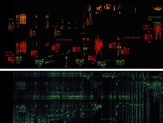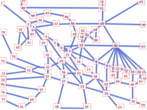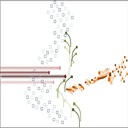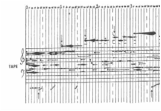|
Vickery, L. (2016). Hybrid Real/Mimetic Sound Works. Tenor 2016, 27-29 May 2016
Anglia Ruskin University, Cambridge, UK 
This paper describes a project to construct a process allowing for data interchange between visual and sonic media: to create a continuum in which sound could be visualized and then resonified through by both live performers and digital means.
A number of processes to aid this visualisation/sonification “ecosystem” were developed. Software was created to create scores based on sonic features of “field recordings” through spectral analysis by rendering the frequency of the strongest detected sinusoidal peak of a recording vertically and its timbral characteristics by luminance, hue and saturation on a scrolling score. Along similar principals a second process was developed to generate a realtime score using graphical symbols to represent detected accents in “found sound” speech recordings. In the other direction software was built to render greyscale images (including sonograms) as sound and a second iteration to generate audio from detected analysis parameters. The imperfections in the various transcription processes are intriguing in themselves as they throw into relief the distinctions between the various forms of representation and in particular the timescales in which they are perceived. The implied circularity of processes also opened the potential for re-interrogation of materials through repeated transmutation. This discussion explores these implications in the context of the analysis of field recordings to generate visual representations that can be resonified using both performative (via notation) and machine (visual data-based) processes, to create hybrid real/mimetic sound works through the combination (and recombination) of the processes.
|
Vickery, L. (2016). Rhizomatic approaches to screen-based music notation. NIME2016, Griffith University, Brisbane

The rhizome concept explored by Deleuze and Guatarri has had an important influence on formal thinking in music and new media. This paper explores the development of rhizomatic musical scores that are arranged cartographically with nodal points allowing for alternate pathways to be traversed. The challenges of pre-digital exemplars of rhizomatic structure are discussed. It follows the development of concepts and technology used in the creation of five works by the author Ubahn c. 1985: the Rosenberg Variations [2012], The Last Years [2012], Sacrificial Zones [2014], detritus [2015] and trash vortex [2015]. The paper discusses the potential for the evolution of novel formal structures using rhizomatic structures.
|
Vickery, L., and James. S (2016). Tectonic: a Networked, Generative and Interactive, Conducting. International Computer Music Conference, Utrecht, Holland.

This paper describes the concepts, implementation and context of Tectonic: Rodinia, for four realtime composer-conductors and ensemble. In this work, an addition to the repertoire of the Decibel Scoreplayer, iPads are networked together using the bonjour protocol to manage connectivity over the network. Unlike previous Scoreplayer works, Rodinia combines “conductor view” control interfaces, “performer view” notation interfaces and an “audience view” overview interface, separately identified by manual connection and yet mutually interactive. Notation is communicated to an ensemble via scores independently generated in realtime in each “performer view” and amalgamated schematically in the “audience view” interface. Interaction in the work is enacted through a collision avoidant algorithm that modifies the choices of each conductor by deflecting the streams of notation according to evaluation of their “Mass” and proximity to other streams, reflecting the concept of shifting Tectonic plates that crush and reform each other’s placement.
| ||||||||||||||||||
|
Vickery, L., Terren, M., Gillies, S. Myburgh, J. (2016). Between the Real and the Imaginary: Ecostructural Approaches to Composing with Field Recordings and Acoustic Instruments. Sonic Ecology: Australasian Computer Music Conference 2016, Brisbane

This paper discusses recent works incorporating field recordings and acoustic instruments by four Western Australian composers Sam Gillies, Josten Myburgh, Michael Terren and Lindsay Vickery. In particular, the paper investigates their approaches to issues and techniques of spectral analysis, sonification, coordination of live and prerecorded elements, transcription, resynthesis, transformation and ecostructural considerations. The discussion is framed by an examination of the evolution of the practice of field recordings and acoustic instruments as a genre in light of ideological and technological advancements and impediments. The works are placed in the context of emerging digital technologies deployed in similar work by Jonathan Harvey, James O'Callaghan, Aaron Einbond, Joanna Bailie and Chaz Underriner.
|
Vickery, L. (2016). The Role of Ring Modulation in the Formal Structure of Roger Smalley's Monody for Piano with Live Electronic Modulation.
Sounds Scripts proceedings of the Totally Huge New Music Festival Symposium: Western Australian Art Music: 1970–2015, Perth. 
The notated score for Roger Smalley’s 1972 work Monody consists of a single line performed by a single performer on piano and percussion. The monophonic nature of the work is ambiguous, however, due to the electronic processing of the live performance via ring modulation. In his program notes Smalley claims that by “restricting the piano part to a single monodic line throughout (…) only one set of addition and difference tones is produced and their frequencies can be exactly predicted”. However, the timbres of both the piano and percussion have complex overtone series, and their interaction with the ring modulation process leads to the production of sounds that arguably have features of both timbre and harmony. This paper seeks to investigate this ambiguity and the role that it plays in the structure of Monody, through the comparison of the notated work and spectral analysis of its actual sound in conjunction with discussion of the psychoacoustic notions of the boundaries between timbral fusion and separation.
|
Christiansen, B., and Vickery, L. (2016). Role-Play and Invariance: Two Aspects of Ritual in Roger Smalley’s Ceremony II. Sounds Scripts proceedings of the Totally Huge New Music Festival Symposium: Western Australian Art Music: 1970–2015, Perth.

In Roger Smalley’s Ceremony I the performers move about the stage in an austere choreography that is both integral to the musical form and rich with ritualistic connotations, the ensemble of percussion instruments further suggesting the primitivism of an ancient rite. In stark contrast, Ceremony II and III show almost no signs of this overt physicality or preference for non-pitched instruments, and represent a performance style and instrumental bias more typical of Western concert music. Without the element of theatricality, the relationship of these pieces to their titles must be judged primarily in terms of the musical content. Devices such as repetition, symmetry, instrumental theatre, and non-developmental structures are conspicuous throughout the works, and can be seen to represent the ritualistic characteristics of role-play and invariance. This paper will examine the ritualism that informs the Ceremony series, and, through an analysis of Ceremony II, consider the relationship between these two specific aspects of ritual and the compositional devices through which they are evoked.
| ||||||||||||||||||

